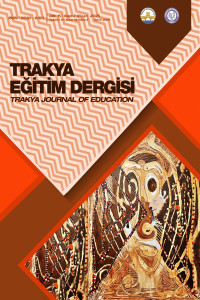Abstract
Hızla gelişen eğitim ortamında teknoloji liderliğini anlamak, özellikle "ISTE-Uluslararası Eğitimde Teknoloji Derneği Standartları" ve "PTLA-Müdürlerin Teknoloji Liderliği Değerlendirmesi" rehberliğinde zorunlu hale gelmektedir. Bu çalışma, "ISTE'ye Dayalı Okul Müdürlerinin Teknoloji Liderliği Ölçeği"ni Türkçe bağlama uyarlayarak ve geçerliliğini ve güvenilirliğini sağlayarak bilgi açığını kapatmayı amaçlamaktadır. Araştırma, Türkiye’nin 21 ilinde 486 devlet okulu müdürünü kapsayan betimsel tarama metodolojisini kullanmıştır. Sonuçlar, ölçeğin Türk eğitim sektörü için uygunluğunu doğrulamıştır. Dikkate değer bir şekilde, teknoloji liderliği; kadın müdürler, ileri derecelere sahip olanlar, 21 yıldan fazla mesleki deneyime sahip müdürler ve 50 veya daha fazla öğretmeni olan okullarda çalışanlar arasında daha belirgin olmuştur. Buna karşılık, 250'ye kadar öğrencisi olan okullardaki müdürler sınırlı teknoloji liderliği sergilemiştir. Mevcut kurumdaki görev süresi anlamlı farklılıklar göstermemiştir. Bu bulgular göz önüne alındığında, eğitim politikacıları teknoloji entegrasyonu stratejisi geliştirirken bu değişkenleri dikkate almalıdır. Gelecekteki çalışmalar, okullarda teknoloji liderliği dinamiklerine kapsamlı bir bakış sağlamak için öğretmenler ve öğrencileri de kapsayacak şekilde odaklarını genişletmelidir.
Ethical Statement
Karabük Üniversitesinden 2022/02 nolu Etik Kurul izni alınmıştır
Project Number
Bu çalışma bir proje kapsamında değildir
References
- AECT. (2021). The definition and terminology committee. Retrieved from https://www.aect.org/about_us.php
- Aktaş, N., & Karaca, F. (2022). The relationship between Turkish high school administrators’ technology leadership self-efficacies and their attitudes and competencies towards technology use in education. Participatory Educational Research, 9(5), 430-448. https://doi.org/10.17275/per.22.122.9.5
- Altınay Aksal, F. (2015). The role of advanced education in shaping proficient technology leaders in schools. Journal of Educational Leadership and Policy, 4(2), 56-67.
- Anderson, J., & Rainie, L. (2014). Digital life in 2025: The future of privacy, copyright, and the ethical use of digital resources. Pew Research Center.
- Argon, T., & Bağmen-Kaya. A. (2020, Şubat). Vizyoner liderlik: Eğitim örgütlerine kavramsal bir bakış [Visionary leadership: A conceptual look at educational organizations]. II. Uluslararası Akdeniz Bilimsel Araştırmalar Kongresi Bildiri Kitabı, 8-28. https://www.researchgate.net/publication/345032212
- Bebell, D., & O'Dwyer, L. M. (2010). Educational technology and 21st century skills: Preparing students for the future. Pearson Education.
- Balcı, A., & Çınkır, Ş. (2002, 16-17 Mayıs). Türkiye'de eğitim yöneticilerinin yetiştirilmesi [Training of educational administrators in Turkey]. 21. Yüzyıl Okul Yöneticisinin Yetiştirilmesi Sempozyumu, Ankara Üniversitesi.
- Banoğlu, K. (2011). Okul müdürlerinin teknoloji liderliği yeterlikleri ve teknoloji koordinatörlüğü [Technology leadership competencies and technology coordination of school principals]. Kuram ve Uygulamada Eğitim Bilimleri, 11(1), 199-213.
- Başaran, İ. E., & Çınkır, Ş. (2013). Türk Eğitim Sistemi ve Okul Yönetimi [Turkish Education System and School Management]. Siyasal Yayınevi.
- Brown, T. A. (2015). Confirmatory factor analysis for applied research. The Guilford Press.
- Cantürk, G., & Aksu, H. (2017). Examining the interplay between professional experience and technological leadership. Educational Technology Quarterly, 9(1), 65-78.
TECHNOLOGICAL LEADERSHIP COMPETENCIES OF SCHOOL PRINCIPALS: SCALE DEVELOPMENT, ADAPTATION, AND EMPIRICAL VALIDATION
Abstract
Understanding technology leadership becomes imperative in the rapidly evolving educational landscape, especially when guided by the "ISTE-International Society for Technology in Education Standards" and the "PTLA-Principals' Technology Leadership Assessment". This study aimed to bridge the knowledge gap by translating and adapting the "ISTE-based Technology Leadership Scale of School Principals" to the Turkish context, ensuring its validity and reliability. The research used a descriptive survey methodology to engage 486 public school principals across 21 Turkish provinces. Results validated the scale's appropriateness for the Turkish educational sector. Notably, technology leadership was more pronounced among female principals, those with advanced degrees, principals with over 21 years of professional experience, and those working in schools with 50 or more teachers. Conversely, principals from schools with up to 250 students showcased limited technology leadership. The tenure at the current institution did not yield significant differences. Given these findings, it is crucial for educational policymakers to consider these variables when developing a strategy for technology integration. Future studies should expand their focus to include teachers and students, ensuring a comprehensive insight into technology leadership dynamics in schools.
Keywords
ISTE Standards Competencies Technology Integration School Principal Professional Development
Project Number
Bu çalışma bir proje kapsamında değildir
References
- AECT. (2021). The definition and terminology committee. Retrieved from https://www.aect.org/about_us.php
- Aktaş, N., & Karaca, F. (2022). The relationship between Turkish high school administrators’ technology leadership self-efficacies and their attitudes and competencies towards technology use in education. Participatory Educational Research, 9(5), 430-448. https://doi.org/10.17275/per.22.122.9.5
- Altınay Aksal, F. (2015). The role of advanced education in shaping proficient technology leaders in schools. Journal of Educational Leadership and Policy, 4(2), 56-67.
- Anderson, J., & Rainie, L. (2014). Digital life in 2025: The future of privacy, copyright, and the ethical use of digital resources. Pew Research Center.
- Argon, T., & Bağmen-Kaya. A. (2020, Şubat). Vizyoner liderlik: Eğitim örgütlerine kavramsal bir bakış [Visionary leadership: A conceptual look at educational organizations]. II. Uluslararası Akdeniz Bilimsel Araştırmalar Kongresi Bildiri Kitabı, 8-28. https://www.researchgate.net/publication/345032212
- Bebell, D., & O'Dwyer, L. M. (2010). Educational technology and 21st century skills: Preparing students for the future. Pearson Education.
- Balcı, A., & Çınkır, Ş. (2002, 16-17 Mayıs). Türkiye'de eğitim yöneticilerinin yetiştirilmesi [Training of educational administrators in Turkey]. 21. Yüzyıl Okul Yöneticisinin Yetiştirilmesi Sempozyumu, Ankara Üniversitesi.
- Banoğlu, K. (2011). Okul müdürlerinin teknoloji liderliği yeterlikleri ve teknoloji koordinatörlüğü [Technology leadership competencies and technology coordination of school principals]. Kuram ve Uygulamada Eğitim Bilimleri, 11(1), 199-213.
- Başaran, İ. E., & Çınkır, Ş. (2013). Türk Eğitim Sistemi ve Okul Yönetimi [Turkish Education System and School Management]. Siyasal Yayınevi.
- Brown, T. A. (2015). Confirmatory factor analysis for applied research. The Guilford Press.
- Cantürk, G., & Aksu, H. (2017). Examining the interplay between professional experience and technological leadership. Educational Technology Quarterly, 9(1), 65-78.
Details
| Primary Language | Turkish |
|---|---|
| Subjects | Education Management |
| Journal Section | Articles |
| Authors | |
| Project Number | Bu çalışma bir proje kapsamında değildir |
| Early Pub Date | April 24, 2025 |
| Publication Date | April 30, 2025 |
| Submission Date | August 29, 2024 |
| Acceptance Date | October 14, 2024 |
| Published in Issue | Year 2025 Volume: 15 Issue: 2 |


